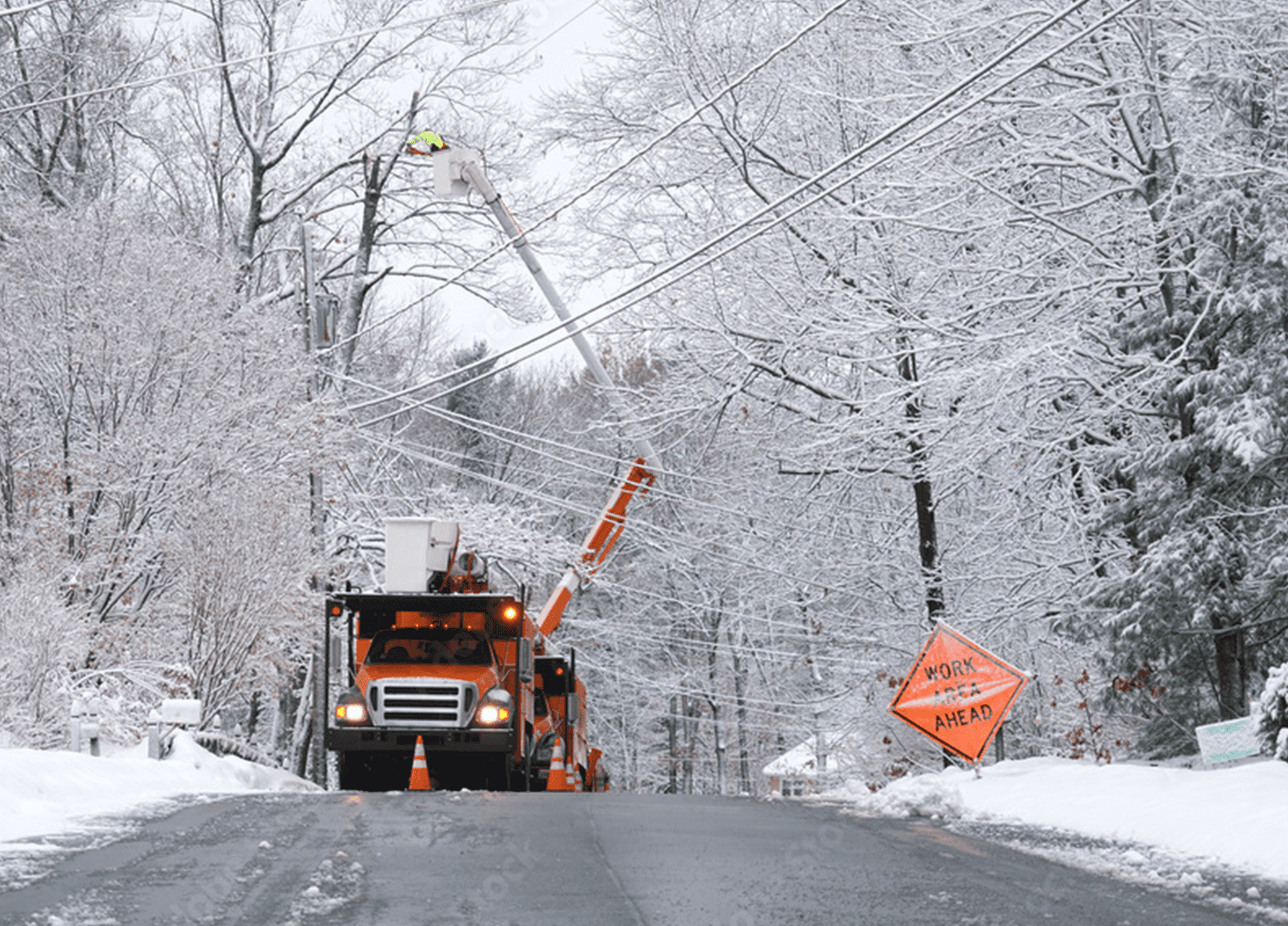
We all know that storms, especially winter ones, can cause power outages. However, a power outage is more than an inconvenience for small businesses. It can ruin products, damage equipment, jeopardize security, and cost lost productivity and sales.
Distributed Energy magazine reports that a 30-minute power outage can cost a midsize business $20,000; an eight-hour interruption can cost as much as $100,000. Annual losses nationwide from outages are estimated to be more than $100 billion! For laboratories, food service businesses, medical offices, and pharmacies, a power outage can cause spoliation. For retailers, a few hours without power can mean significant losses. When point-of-sale (POS) systems are down, customers walk while theft threats increase due to POS vulnerabilities.
What steps have you taken to prepare your facilities and staff for a power failure? What can you do to mitigate the impact on your business? Take a few minutes to review this checklist. Then create a preparedness and recovery plan for your firm.
Before a power outage
- Create an emergency response/continuity plan. Determine the processes and equipment that would be affected by a power outage and the impact it would have on your business. Examples include electrical equipment, computers and printers, internet connectivity, phone, security and alarm systems, elevators, lighting, refrigeration/cooking, and heating and air conditioning.
- Maintain an inventory of your equipment. Create a list of items that will need to be powered down and reset when power is restored. Also, detail how you will recover and restore your operations.
- Have a plan for how employees and customers will safely exit the building. Post exit plans throughout your office or facility. Rehearse the exit plan. Assign an employee to be in charge of assisting with the evacuation. Also, assign an individual to help persons with disabilities.
- Obtain an alternate source of power. Consider buying a generator to keep your computer systems and key equipment running. Test your generator monthly, and make sure you have extra fuel. Note: Only use generators in well-ventilated spaces, away from windows, and never indoors.
- Install surge protectors for computers and other sensitive electronic equipment.
- Back up your computer data frequently. Save your working files to the cloud so they can be accessed remotely. Store backup copies of your data in a secure off-site location.
- Install smoke detectors and sprinkler systems. Make sure your emergency detection and fire control system meets building code standards, that it’s tied to your local fire department and it has a battery backup.
- Establish an emergency alert system with several ways of warning your employees — by text, email, announcement, and an alarm system in your building. Rehearse the emergency alert system in place so employees will recognize the alert and know how to respond in a real emergency.
- Install battery-powered lighting to illuminate exits and stairwells. Ensure your employees know the quickest and safest way to exit the building. Never obstruct exits.
- Have a designated place to gather. Employees should know where to gather in an outage. Rehearse gathering at the location and establish a head-count protocol to make sure all employees are accounted for.
- Store emergency supplies and alternate methods of contact. Keep flashlights, walkie-talkies, an emergency radio, bottled water, and a first-aid kit in an easily accessible location. Include copies of your emergency-response plan and contact information. Make sure you have a way to contact the police or fire department. Consider purchasing an NOAA Weather Radio All Hazards receiver, which receives broadcasts directly from the National Weather Service. Install a landline phone that works when the power is out (e.g., not a Wi-Fi phone since this will be disabled in an outage).
- Train your employees. Good communication and frequent training are key to successfully responding to an emergency. Train your employees on your emergency plan, and regularly test and practice your plan. Supervisors should know their role during an emergency and have a system for accounting for staff. Maintain an updated list of your employees and their contact information. Establish a procedure for checking in with them to ensure they are safe.
- Take care of your customers. If you have customers or clients visiting your premises, make sure you have a plan to safely direct them to the exits.
- Review your insurance coverage. Talk to an insurance professional about commercial general liability and property insurance, sometimes bundled as a business owner’s policy (BOP). Ask about utility service interruption coverage and equipment breakdown insurance, available as endorsements to your commercial property insurance. You may also want business income (business interruption) insurance to cover the loss of income after a disaster or an umbrella policy to increase your liability coverage. Maintain a photo or video inventory of your premises, equipment, and inventory if you need to file a claim.
During a power outage
- Activate your emergency response plan. Make sure your employees and customers are safe. Notify utilities that your power is out. Alert local authorities if necessary.
- Establish backup power. If you have backup power, check to see if it is working. Depending on how long the power is out, you may need to add fuel to your generator.
- Safely turn off equipment. If the power is completely out, safely turn off your equipment. Make sure each employee follows the same procedures before leaving their workstation.
- Institute shutdown procedures. You may need to completely close and lock your facilities. Remember that some security systems may not work with the power out.
- Stay informed. Approximately 44% of power outages are caused by storm-related events, according to the Federal Emergency Management Agency (FEMA). Include a battery-powered radio in your emergency supplies to stay apprised of weather conditions. You can also subscribe to free text and email warnings to get weather updates and news from your local police. Keep your employees informed of weather threats and update them on the status of your facilities.
- Communicate with key stakeholders. If the power is out for an extended period and will interrupt your business, contact contractors, suppliers, customers, shareholders, and regulators.
After a power outage
- Execute your recovery plan. Focus on restoring your critical business functions first. If you don’t yet have full power, determine which activities can wait and which are essential. When can your employees return if you were forced to evacuate because of a fire or flood? Designate someone from each business function to check on your facilities and begin restoration.
- Have a checklist of items you need to restore. To smoothly get back in business, check to see if the following are working: electricity and other utilities; heating, ventilation, and air conditioning system; faucets and toilets; computers, networks, and internet service; telephones and office equipment, and refrigerators/freezers, and other equipment you need to do your work.
- Bring technology back online. Power up your computers and office equipment. Check to see if you have internet connectivity. An IT consultant may need to restore your networks. Check to see if you have received emails sent during the outage. Restore customer accounts such as orders and billing.
- Reopen your business. If you run a retail establishment, make sure your cash registers and point-of-sale networks are operational. For restaurants and labs, you will need to take special care that refrigerators, freezers, air filtration, ovens, and other specialty equipment haven’t been damaged and are operating at full capacity.
- Check equipment for damages. Contact your insurance agent if you need to file a claim. Document the damage using photos or video.
- Debrief. What did you handle well, and what needs to improve? Do you need to update your emergency response plan? Does staff need additional training?
In 2021, Hurricane Ida created service outages for 1.2 million electricity customers across eight states, according to a US Department of Energy report. And FEMA says 70% of businesses will experience an outage in the next 12 months. Extreme weather, cyberattacks, and other infrastructure issues have put the electrical grid at risk. It’s not a matter of if but when you’ll experience a power outage. Make sure you’re ready when the electricity goes out.
Call your insurance advisor.
Give us a call so we can discuss your risk exposure and ensure you have the proper insurance coverage for when the power goes out. 800-392-6532.
This content is for informational purposes only and not for the purpose of providing professional, financial, medical, or legal advice. You should contact your licensed professional to obtain advice with respect to any particular issue or problem.

